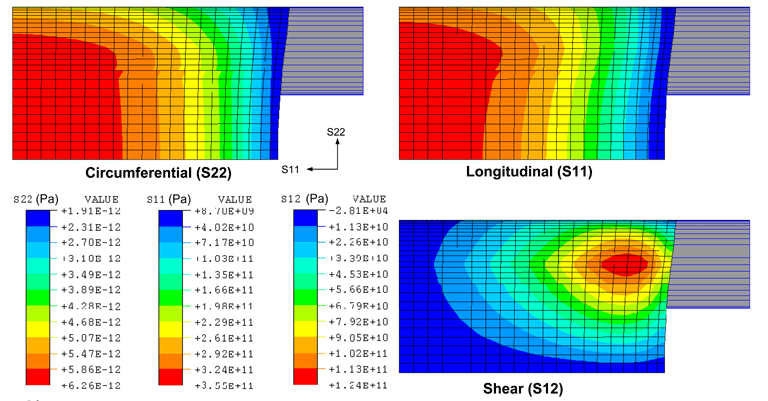Principal Investigator: Tom Franz
The long-term success of tissue-engineered vascular grafts comprising synthetic materials depends largely on the host response. Porosity is a key factor for mitigation of foreign body response and inflammation. Poor clinical outcomes observed with small and medium-calibre synthetic grafts are mainly attributed to ongoing thrombogenicity and anastomotic intimal hyperplasia. The excessive thickening of intimal tissue in the peri-anastomotic graft region is caused by variations in wall shear stress, exacerbated by compliance mismatch between the host artery and prosthetic implant, and often results in late graft failure. This research is concerned with mechanical challenges in the development of elastomeric vascular grafts comprising a blood barrier component and a structural reinforcement – which is hoped allow for regeneration of viable, endothelialized tissue in contrast to clinically used ePTFE and Dacron grafts.
Characterisation of Time-dependent Mechanical Properties of Biodegradable Scaffolds
H Krynauw, L Bruchmueller, D Bezuidenhout, T Franz
This study focuses on the characterisation of the time-dependent mechanical properties of degradable electro-spun scaffold during degradation. This information will be important for the computational biomechanics research on electro-spun vascular grafts, as the change in mechanical properties affects the structural stability of the graft. To provide structural integrity of the regenerating blood vessel, the loss in mechanical strength of the scaffolds needs to be proportional to the regenerating vascular tissue, otherwise drawbacks in function can occur. The study involves the manufacture of hydrolytically degradable porous polymeric scaffolds by electro-spinning. These scaffolds are then subjected to in vitro degradation. Mechanical characterisation of the scaffolds is conducted at various time points during the degradation process.

This work has been supported financially by the National Research Foundation of South Africa.
Structural Design Aspects of Mesh-reinforced Composite Grafts
MS Sirry, T Franz
Finite element methods are employed to predict the structural properties and mechanical behaviour of a porous polyurethane scaffold reinforced with a knitted wire mesh. Two different ways of combining the wire mesh and the porous structure, embedding and external reinforcement, are combined with two alternative wire materials, polyurethane and superleastic Nitinol. Whereas the non-reinforced porous polyurethane graft suffers excessive radial compliance (70 %/100mmHg), physiological arterial compliance of between 7 - 15 %/100mmHg is predicted numerically for the reinforced grafts.


This work was supported financially by the National Research Foundation of South Africa.
Adventitial-style Porous Graft System developed with FEM and Genetic Algorithms
MS Yeoman, D Bezuidenhout, BD Reddy, T Franz
This study is concerned with the design of a fabric-reinforced porous vascular graft, in particular the development of a polymeric knit fabric providing, together with compliant polyurethane structures, a graft compliance of 6.0%/100mmHg and nonlinear stiffening. Finite element methods and genetic algorithms were used to assess various choices of graft and fabric, and to optimise the fabric material properties. The polyurethane structures with well defined, interconnecting porosity and the fabric were represented through an experimentally validated hyperfoam material model and a modified anisotropic strain energy function. Non-reinforced grafts exhibited excessive compliance (16 to 32 %/100mmHg) while The fabric reinforced grafts closely matched the target compliance (6 - 7 %/100mmHg). Nonlinear stiffening with onset at 35mmHg was observed for the reinforced grafts, in contrast to linear pressure-diameter change relationships for the non-reinforced grafts resulting in considerable dilation.

Stress distribution in optimal fabric-reinforced graft for circumferential tension
Mathematical Modelling of Ingrowth Spaces
T Franz, D Bezuidenhout
Objective of this project was to theoretically describe the dimensions available for vascular ingrowth in synthetic scaffolds featuring inter-connected porosity. Of main interest was the formulation of relationships between ingrowth depth and tranverse dimensions along the ingrowth path, representing passage of capillaries through synthetic scaffolds (see Fig. 1).
The well-defined and regularly inter-connected pores allowed for approximation with a dodecahedron. The diameter of the inscribed sphere, diameter of circle incribed in one pentagonal face, and the diameter (thickness) of the edges were used as prinicpal geomtrical parameters of the dodecahedron. By adjusting these dodecahedral parameters (Fig. 2), the diameter of a pore and interconnecting windows could be simulated closely for various pore size ranges.
Although dodecahedron does not allow ideal 3D packing, three principal, distinctly different routes of passage could be simulated by assembling dodecahedrons in different configurations (Fig. 3).




